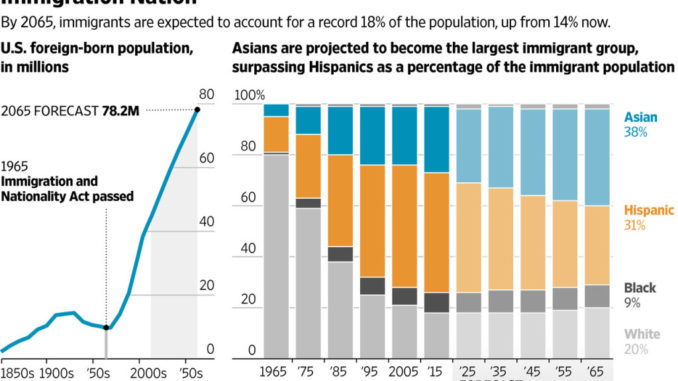
by Miriam Jordan, WSJ
Fueled by arrivals from Asia, immigrants and their children will account for the lion’s share of U.S. population growth over the next 50 years, according to a Pew Research Center study.
Between 2015 and 2065, the U.S. population is expected to increase 36% to 441 million. Immigrants and their offspring will make up 88% of that increase, or 103 million people, according to the new research.
The projections, which account for both legal and illegal immigration, are based on analysis of government data from the U.S. Census, held every 10 years, and the American Community Survey, which samples a percentage of the population every year.
In a shift, Asians now represent the only group whose numbers are rising because of immigration—and they are on pace to surpass Hispanics as the largest foreign-born group in 2055, the study found.
“Migration from Latin America, particularly Mexico, has slowed sharply,” said Mark Lopez, co-author of the study. “Meanwhile, Asian immigration has been steadily rising, especially from China and India.”
The Hispanic share of the immigrant population, 47% in 2015, will drop to 31% by 2065. Asians will rise to 38% of the total, compared with about one-quarter today, the study estimated.
Bolstered by Asian arrivals, the U.S. is on course to have no racial or ethnic majority group by 2055. That year, the country is expected to be 46% white and 24% Hispanic, with Asians representing 14% of the population—surpassing blacks, who will account for 13%. Today, the U.S. is 62% white and 18% Hispanic. “With the U.S. population becoming more diverse, this has the potential to reshape American politics,” Mr. Lopez said.
In the 1970s, newcomers mainly hailed from Europe. Spurred by record Mexican immigration, Latin America was the main region of origin from 1990 until recently. But since 2011, Asia has emerged as the largest source of immigrants. Nearly two-thirds of Asians in the U.S. today are foreign-born, compared with 37% of Hispanics.
Among them are tens of thousands of Indian and Chinese students. After graduating, many remain in the country on temporary work visas and eventually apply for legal permanent residency. Five years after obtaining a green card, they can apply for U.S. citizenship.
Haiyan Wu left China in 2007 to study computer science at the University of San Francisco. Her employer, a local technology company, is sponsoring her for a green card. Ms. Wu, 30 years old, said that she wishes to remain in the U.S. long term, and imagines raising a family in America. “Everything is happening in the U.S. as far as software technology,” she said. “You get the most opportunities.”
Arrivals from Mexico, the nation responsible for the largest wave of contemporary immigration to the U.S., have slipped and are unlikely to return to their pre-2007 level, according to demographer Jeff Passel, the study’s co-author.
Mexican arrivals are the lowest in five decades as a share of all immigrant arrivals, or 15% in 2013. Several factors are behind the trend, which has resulted in a steep decline in illegal immigration compared with a decade earlier. Chief among them is the lower birthrate in Mexico, which has reduced pressure on heads of households and other family members to seek higher-paying jobs in the U.S. The relative stability of the Mexican economy and the perils of making the journey have also dissuaded migration.
Although immigration will continue to contribute to growth of the U.S. Hispanic population, births in the U.S. to Latinas will be the main driver, according to the study.

